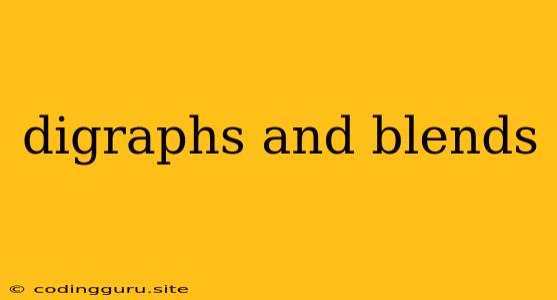Digraphs and Blends: Mastering the Magic of Two-Letter Sounds
Learning to read and write is a wonderful journey, filled with fascinating discoveries. But sometimes, the English language can be a bit tricky, especially when it comes to sounds. That's where digraphs and blends come in. These special combinations of letters create sounds that we don't always expect! So, let's dive in and explore the magic of these letter duos.
What are Digraphs?
Digraphs are two letters that work together to represent a single sound. Think of them as secret codes that unlock special sounds. Some common digraphs include:
- sh - as in ship
- ch - as in chair
- th - as in thin
- ph - as in phone
- wh - as in where
- ck - as in sock
- ng - as in sing
Digraphs can sometimes be a bit confusing, as they can sound different depending on the word. For example, the digraph "th" can sound like "th" as in thin, or "th" as in this. But don't worry, practice and a bit of patience will help you master these tricky pairs!
What are Blends?
Blends are groups of two or three consonants that are blended together to create a unique sound. Unlike digraphs, each letter in a blend still holds its own sound, but they come together to form a single unit. Here are some common blends:
- bl - as in blue
- cl - as in cloud
- fl - as in flower
- gl - as in glass
- pl - as in play
- sl - as in sleep
- br - as in brown
- cr - as in crab
- dr - as in drum
- fr - as in frog
- gr - as in green
- pr - as in present
- tr - as in tree
- scr - as in scream
Blends can make words a bit longer, but they also add a touch of fun and interesting sounds to our language.
How Can We Learn Digraphs and Blends?
Learning digraphs and blends can be a fun adventure! Here are some helpful tips:
- Read, read, read! The more you read, the more you'll encounter digraphs and blends in action. This will help you recognize these letter combinations and their sounds.
- Use flashcards. Create flashcards with digraphs and blends on one side and their corresponding sounds on the other. Use these flashcards to practice reading and spelling words.
- Sing songs. Many fun songs incorporate digraphs and blends, making learning engaging and enjoyable.
- Play games. There are many games that focus on digraphs and blends, making learning interactive and fun.
- Write stories. Encourage children to write short stories using digraphs and blends. This will help them apply what they've learned in a creative context.
Examples of Digraphs and Blends in Action
Let's see some examples of how digraphs and blends work in words:
- ship (sh is a digraph)
- chair (ch is a digraph)
- thin (th is a digraph)
- phone (ph is a digraph)
- where (wh is a digraph)
- sock (ck is a digraph)
- sing (ng is a digraph)
- blue (bl is a blend)
- cloud (cl is a blend)
- flower (fl is a blend)
- glass (gl is a blend)
- play (pl is a blend)
- sleep (sl is a blend)
Conclusion
Digraphs and blends may seem challenging at first, but with practice and a bit of fun, they can become your secret weapon for reading and writing. By understanding how these letter combinations work, you'll be able to unlock a world of new sounds and words. So, embrace the magic of two-letter sounds and watch your reading and writing skills soar!
